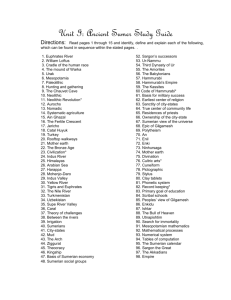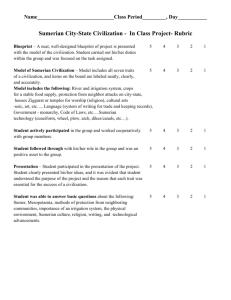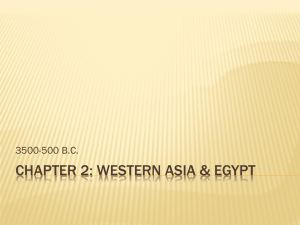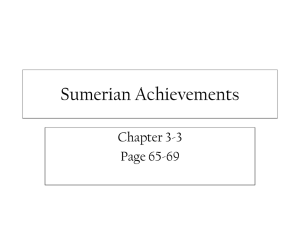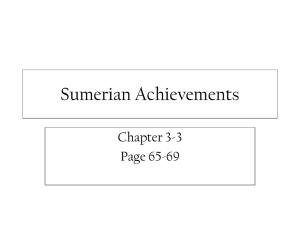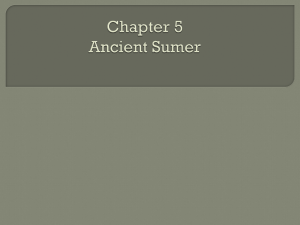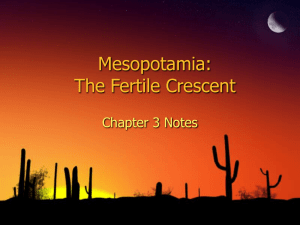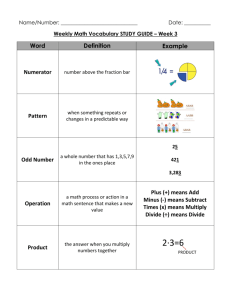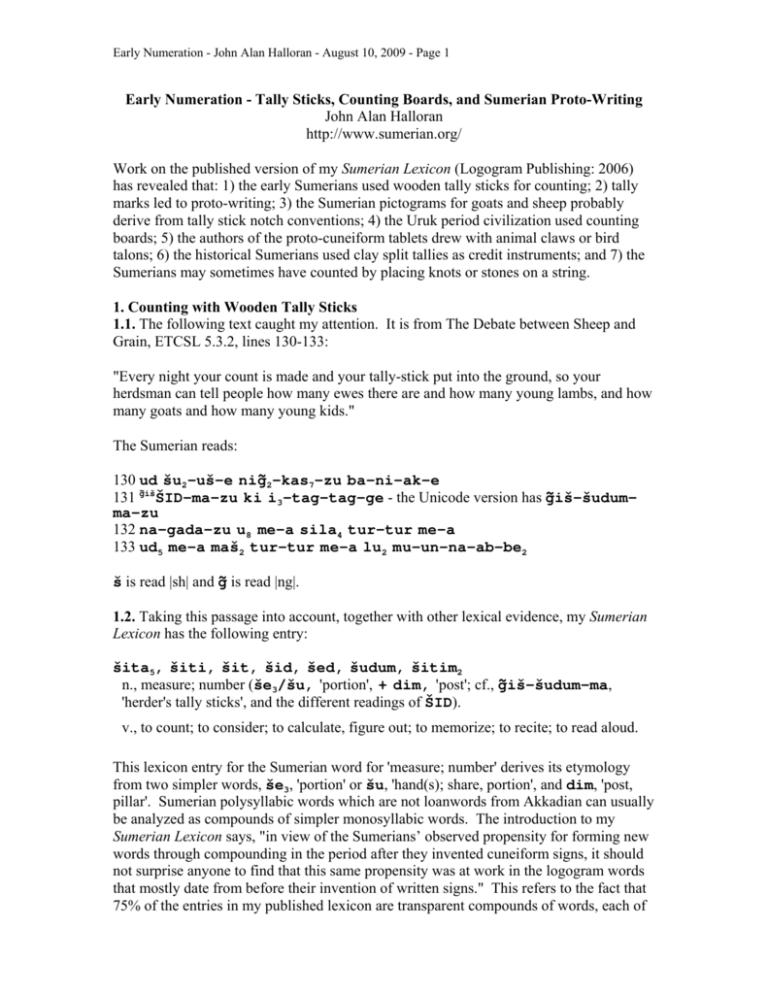
Early Numeration - John Alan Halloran - August 10, 2009 - Page 1
Early Numeration - Tally Sticks, Counting Boards, and Sumerian Proto-Writing
John Alan Halloran
http://www.sumerian.org/
Work on the published version of my Sumerian Lexicon (Logogram Publishing: 2006)
has revealed that: 1) the early Sumerians used wooden tally sticks for counting; 2) tally
marks led to proto-writing; 3) the Sumerian pictograms for goats and sheep probably
derive from tally stick notch conventions; 4) the Uruk period civilization used counting
boards; 5) the authors of the proto-cuneiform tablets drew with animal claws or bird
talons; 6) the historical Sumerians used clay split tallies as credit instruments; and 7) the
Sumerians may sometimes have counted by placing knots or stones on a string.
1. Counting with Wooden Tally Sticks
1.1. The following text caught my attention. It is from The Debate between Sheep and
Grain, ETCSL 5.3.2, lines 130-133:
"Every night your count is made and your tally-stick put into the ground, so your
herdsman can tell people how many ewes there are and how many young lambs, and how
many goats and how many young kids."
The Sumerian reads:
130 ud šu2-uš-e niñ2-kas7-zu ba-ni-ak-e
131 ñišŠID-ma-zu ki i3-tag-tag-ge - the Unicode version has ñiš-šudumma-zu
132 na-gada-zu u8 me-a sila4 tur-tur me-a
133 ud5 me-a maš2 tur-tur me-a lu2 mu-un-na-ab-be2
š is read |sh| and ñ is read |ng|.
1.2. Taking this passage into account, together with other lexical evidence, my Sumerian
Lexicon has the following entry:
šita5, šiti, šit, šid, šed, šudum, šitim2
n., measure; number (še3/šu, 'portion', + dim, 'post'; cf., ñiš-šudum-ma,
'herder's tally sticks', and the different readings of ŠID).
v., to count; to consider; to calculate, figure out; to memorize; to recite; to read aloud.
This lexicon entry for the Sumerian word for 'measure; number' derives its etymology
from two simpler words, še3, 'portion' or šu, 'hand(s); share, portion', and dim, 'post,
pillar'. Sumerian polysyllabic words which are not loanwords from Akkadian can usually
be analyzed as compounds of simpler monosyllabic words. The introduction to my
Sumerian Lexicon says, "in view of the Sumerians’ observed propensity for forming new
words through compounding in the period after they invented cuneiform signs, it should
not surprise anyone to find that this same propensity was at work in the logogram words
that mostly date from before their invention of written signs." This refers to the fact that
75% of the entries in my published lexicon are transparent compounds of words, each of
Early Numeration - John Alan Halloran - August 10, 2009 - Page 2
which have their own written signs. But I claim that many Sumerian words that have just
one written sign also result etymologically from a combination of two simpler words. As
a spoken language, Sumerian had a long history before the invention of writing. So I
think that many Sumerian words are the result of compounding during that long time
period. The etymology of šudum, 'to count', which involves simple Sumerian words for
'portion' and 'post or stake', appears to be strong. The vowel and consonant changes are
normal because the language tries to achieve phonetic harmony through different types of
assimilation including vowel harmony. The etymology, referring to notched tally sticks
put into the ground by shepherds, describes the origin in Sumerian of number counting.
1.3. What exactly is a tally stick? One cannot surpass the very learned, illustrated 28page Tally Sticks chapter in Number Words and Number Symbols: A Cultural History of
Numbers, by Karl Menninger. [Originally published in German as Zahlwort und Ziffer in
1934 and 1958, M.I.T. Press published a revised English edition in 1969. They describe
him as a "distinguished German scholar" whose "work embraces the full span of recorded
history as it unfolded in cultures throughout the world." His investigation of worldwide
counting practices can help clarify the meaning and function of evidence and practices
that are found in a particular culture.] The simplest tally stick is a number stick, a stick
with as many notches as what the owner wanted to record. Humans have made these
notches not just in wood, but also in bone, ivory, shell, and rock. Menninger says,
"Number sticks have been used in every period and by all peoples." (p. 226).
The illiterate, unschooled farmer still "had to keep track of his crops and livestock and
harvests. The peasant could also be a creditor or a debtor. Where did he get the numerals
to reckon with?" "From no one but himself! He developed his own number signs, which
were adequate for his own ordinary dealings, and which no one but himself could read
and understand." (p. 223) "In the history of language, this is the earliest forerunner of the
art of writing." (pp. 223-24) Before writing represented spoken language and before
there were standardized systems, illiterate farmers and merchants used idiosyncratic
systems of their own devising to record quantities of products. This is not sufficiently
recognized in modern works on the origin of writing. Tallies to record commodity
quantities were idiosyncratic symbolic marks that did not necessarily have phonetic
counterparts. Written signs originated to meet everyday needs, not to represent spoken
language. Menninger traces the words for writing in many languages back to words for
carving, cutting, or scratching. Furthermore, in bound collections of notched tally sticks
or tablets of beech wood he sees the ancestor of the modern buch or book. He also
convincingly traces the basic Roman numerals to tally stick notation conventions.
1.4. It should help students trying to decipher examples of proto-writing from different
cultures to learn that, "A study of tally sticks reveals two very important things about
early written numerals:
"The crossing of a carved symbol most frequently means a grouping, usually 10.
"Half the symbol stands for half its normal value." (p. 242)
Thus when X means 10, V means 5 - see the Wikipedia article about Roman numerals,
Origins at http://en.wikipedia.org/wiki/Roman_numerals.
Early Numeration - John Alan Halloran - August 10, 2009 - Page 3
2. Proto-Writing and Tally Marks
2.1. The tally stick conventions described by Menninger appear also to have inspired the
early script of Old Europe, which developed in the middle and lower Danube basin
starting around 5,300 BCE, calibrated. Although different theories have been proposed
about the signs found on 940 inscribed objects excavated from the Vinča-Tordos region
of Transylvania, Eric Lewin Altschuler and Nicholas Christenfeld have shown that nearly
one-third of the inscribed pottery objects bear numerical inscriptions. They suggest that
the script of Old Europe may have been used for economic purposes, The Number
System of the Old European Script, 9 Sep 2003, [math.HO] at
http://arxiv.org/html/math/0309157v1. A literature search fails to find any student of this
ancient script who references the tally marks chapter of Menninger's book, probably
because nothing about the title, Number Words and Number Symbols, indicates that it is
about the history of writing, However, if one goes back far enough, economic tally
marks are very relevant to the origins of writing. Altschuler and Christenfeld describe
how to read the number signs on the Old European Script ('OES') inscriptions - the score
marks, the 'comb' motif, and the 'telephone pole' motif. They suggest that the common
OES signs V and X or + should be read as 10 and 20. Then, confirming Menninger's
description of tally marks as informal writing meant to be read only by its users, Lewin
and Christenfeld say, "It might be wondered why the same number is written in more
than one way. For a number of reasons we think this is not surprising and is probably
even expected. First, as the script was in use for hundreds of years over hundreds of
square kilometers we would expect some variation. Second, it must be remembered that
standardization is a concept of modernity."
2.2. We should refer to these signs not as writing, but as proto-writing, until such time as
the ancient pictograms and the more abstract ideograms can be clearly discerned to have
evolved into logograms for representing the words of spoken language. David Crystal's
Dictionary of Language and Languages defines Writing as, "The process or result of
recording spoken language using a system of visual marks on a surface."
2.3. Nissen, Damerow, and Englund describe and illustrate on page 20 of Archaic
Bookkeeping, Uruk IV-period "tags consisting of small, transversely perforated tablets,
usually containing but few ideographic signs and no numerical notations. These signs do
not belong to the well-known repertoire of symbols representing goods such as plants,
animals, textiles, and metals. The tags therefore may carry personal names and were
probably attached with a string to containers or other items, stating the proprietor or
receiver of such goods." The idiosyncratic identifying signs on these Mesoptamian clay
tags may be compared to other undeciphered short sequences of signs, such as the 'Vinca
script' found in Old Europe or the 'Jiahu script' found on tortoise shells in China, both
dated to about 6,000 BCE. They may also be compared to the emblems adopted and
worn by different U.S. Army divisions towards the end of World War I in Europe
(discussed by Claude Levi-Strauss on page 7 of his book Totemism). Emblems that
distinguish the property of tribes, families, and individuals serve utilitarian purposes.
Humans can use pictograms, ideograms, and emblems in systematic ways without having
them be a system for encoding the words of spoken language. But, starting in Sumer in
the early third millenium BCE, ancient proto-writing did gradually merge with spoken
language to create true writing, and the totemistic or idiosyncratic signs began to fall
Early Numeration - John Alan Halloran - August 10, 2009 - Page 4
away, to be replaced by more language-mediated identifiers or names that could be
represented with a socially-taught standard symbol set.
3. Sumerian Goat and Sheep Pictograms from Tally Stick Conventions
3.1. The Sumerian MAŠ sign with the word-meaning of '(male) goat' was a simple cross.
The Sumerian LU or UDU sign with the word-meanings of 'many' and '(male) sheep' was
a cross inside a circle. The symbol of a cross inside a circle having the abstract meaning
'sheep' may already be present among the complex tokens found at Uruk in the fourth
millenium, according to their primary investigator, Denise Schmandt-Besserat (Beyond
Writing, vol. 1, 1992, p. 152). Following Jöran Friberg, she says that, at least in Elam
and Uruk, a cylinder token represented one herd animal and a lenticular disk represented
10 herd animals. But, during the fourth millenium Uruk period, tokens with complex
markings replaced the plain tokens that had functioned for millenia, driven by the need
for greater precision and accuracy in large production centers. Disks were marked
differently to count lambs, ewes, and sheep. The mystery why such an abstract symbol as
a cross came to represent goats and sheep in the Near Eastern clay token system and
Sumerian pictograms is solved when one realizes that, outside the urban centers where
complex tokens and writing arose, shepherds traditionally counted goats and sheep by
making notches on tally sticks - and shepherds used the cross convention to record groups
of goats and sheep.
3.2. The simple cross does not have a numerical meaning in written Sumerian, but the
tally mark symbolism of the cross in a circle meaning 'many' is preserved in an alternate
reading for the Sumerian sign of the circled cross. When the sign is read udu, it means
'sheep', but sometimes it must be read lu, meaning 'many, much; to be/make numerous,
abundant'. The Wikipedia article on Roman Numerals says that the circled or boxed X or
+ meant 1000, see Menninger's Fig. 70. Menninger also illustrates a line crossed over
with a double crossing, which means 10 x 10 = 100. Note that the Sumerian pictogram
that means both an, 'heaven', and diñir, 'deity', is a line with a triple crossing, which
would mean 10 x 10 x 10 = 1000. The pictogram for 'heaven' and 'deity' is traditionally
called a 'rosette' or 'star', and it is true that three such signs had the meaning 'star', but the
stars of the sky also convey the idea of a large number (the Sumerian word for 'thousand',
lima, signifies 'overwhelming, awesome, fearsome' - the direction of borrowing
between Akkadian l‰m and the Sumerian is not clear - the Sumerian word for four is
limmu and 1000 is 400 greater than 600, an important large number in the Sumerian
sexagesimal counting system). The line with the triple crossing is also found in the
Sumerian sign ama for 'mother', enclosed in a container-sign that most resembles the
signs for amar, 'calf; young animal' and tin, 'life', but because the line with the triple
crossing can be read an, 'sky', Sumerologists have traditionally seen the symbol as a
meaningless phonetic indicator for ama. Seeing the symbol as a line with a triple
crossing would emphasize instead the generative fecundity of mothers.
Early Numeration - John Alan Halloran - August 10, 2009 - Page 5
4. The Pictogram for 'Number' and Counting Boards
4.1. The lexical lists give many readings for the cuneiform sign that represents the
Sumerian 'measure/number' word mentioned above in section 1.2, the ŠID sign, where
the same sign is called the SANGA sign in proto-cuneiform studies. The major readings
were: šita5, šid; lag; silañ; sañña, umbisañ; šudum; zandara;
šub6. What did the sign look like?
4.2. In 1929 Prof. Dr. Eckhard Unger of Berlin University described the pictogram that
became the ŠID sign as 'Tontafel mit Querstrichen (Zeilen) und Griffel' ('clay tablet with
lines and stylus'; Die Keilschrift : Entstehung, System und Ornamentik der Schrift der
ältesten Hochkultur, Leipzig, 1929).
4.3. In 1990, Peter Damerow and Robert Englund described the use of tallying boards for
doing calculations - "How such calculations were performed is not understood in detail.
Instruments that could have served as calculation aids are as yet not attested in
archaeological finds, or have not been identified as such. Lexical lists from later periods,
however, suggest that the Sumerians used tallying boards made of wood, which being
perishable would not have been unearthed in excavations. There is also some evidence
that the sign SANGA, designating the chancellor of an economic unit, derives from a
pictogram depicting such a tallying board. This, in fact, is supported by the cuneiform
sign ŠID which, also having developed from this sign, was employed as an ideogram
with the meaning "account."" Archaic Bookkeeping : Early Writing and Techniques of
Economic Administration in the Ancient Near East, Chicago and London, 1993, p. 134
(originally published as Frühe Schrift und Techniken der Wirtschaftsverwaltung im Alten
Orient by H.J. Nissen, P. Damerow, and R. Englund, Berlin, 1990). Elsewhere (in the
Journal of the American Oriental Society 121.3 (2001), p. 499, in his review of Giuseppe
Visicato, The Power and the Writing: The Early Scribes of Mesopotamia, Bethesda, Md.,
2000), Englund acknowledges a private communication from Jöran Friberg for the
suggestion that "the original referent of the sign SANGA might have been a counting
board to which a box containing early "tokens" was attached on the lower left."
4.4. In 1993, Petr Charvát described the earliest form of the related DUB sign as
consisting "of a rectangular handled frame filled in by a lattice pattern of intersecting
oblique lines. The model for this sign must have been a tablet of some hard but probably
organic material (wood or bone) bearing the crossed lines provided for better adherence
of the soft writing surface, most probably a wax filling into which individual signs were
incised. Such a tablet of wood has been found in the much later shipwreck of Ulu Burun,
Turkey (fourteenth century BNC: Payton 1991). That the tablets could also have been
cut from bone is indicated by data concerning the most ancient annals of Egypt (Kaplony
1991, 198)." Mesopotamia Before History, London and New York, 2002, p. 152 (orig.
published as Ancient Mesopotamia, Prague, 1993, pp. 159 and 203). There are lexicon
entries which support the existence of wax-filled writing boards - see the Sumerian
Lexicon entries for ñiš-da, kam3, and lal3-þur and the Akkadian word l®’u(m),
"writing-board of wood infilled with wax." (A Concise Dictionary of Akkadian, 1999).
Early Numeration - John Alan Halloran - August 10, 2009 - Page 6
4.5. Page 99 of Yushu Gong, Studien zur Bildung und Entwicklung der
Keilschriftzeichen, Hamburg, 1993, has a table showing the variation in the DA, ŠU, KID
and SANGA signs between Uruk IV, Uruk III, Ur, and Fara, for the purpose of showing
how the number of lines could vary in early signs like these that featured parallel lines.
Gong does not speculate on what the SANGA sign might represent.
4.6. A fuller account of the evolution and meaning of the SANGA sign appears in JeanJacques Glassner, Écrire à Sumer : L'invention du cunéiforme, Seuil, 2000, pp. 141-149
(English translation: The Invention of Cuneiform Writing in Sumer). A list that
enumerates the titles of the SANGA and the gal:SANGA comes to us in an Eblaite
version in which the signs are written syllabically. Instead of the SANGA sign, appears
um-bí-sa-ga-im (the ePSD quotes Ebla Sign List 16 and shows ub2#-bi2-sa-gaim), in which we recognize the following early Sumerian word:
umbisañ[SANGA/ŠID]
scribe; administrator (umbin, 'nail impression [on a tablet]', + sañ, 'counted head').
This early reading of the SANGA sign gradually became obsolete, with the scribe and
administrator functions being taken over by two new titles. Glassner describes how the
term dub-sar, 'scribe', gradually replaces umbisañ and dub-umbisañ, 'scribe', as
one moves from the archaic period tablets to the Fara / Šuruppak period tablets (ca. 2650
BCE). The interchangeability of sar, 'to inscribe', and umbisañ suggests that
umbisañ had a verbal meaning, such as 'to count heads by making nail impressions'.
The dub-umbisañ was one who did so on a dub, a writing board or tablet. The term
sañña/sanga apparently evolved from umbisañ to refer just to the administrator
function. The 'leader' semantics of sañ, 'head', may have contributed to this switch,
although sañña looks like it has a more complex etymology. Based on the Ebla list, the
shift from umbisañ to sañña as 'administrator' occurred later than did the shift to
dub-sar for 'scribe'.
4.7. The Cuneiform Digital Library Initiative (CDLI) site at http://cdli.ucla.edu/ identifies
three forms of the SANGA sign in the early Uruk IV period. In this period, SANGA~a
occurs 96 times, SANGA~b occurs 15 times, and SANGA~c occurs 2 times. The forms
that the SANGA sign could have are illustrated in the following.
Figure 1, CDLI #P002207, 1. GIR3~b DUB~c SANGA~c
Early Numeration - John Alan Halloran - August 10, 2009 - Page 7
The above shows all that is on this beautiful tablet. The ÑIR3 sign can represent the god
Šakkan, protector of wild animals, so this inscription could be the name of a scribe.
Figure 2, CDLI #P000958, Col. 3, 2. 1(N01) , BU~a SANGA~b
The above is 1 entry from a tablet of 31 entries, which says on the reverse 5(N14)
4(N01), GU4# AB2. The N14 sign is a factor of 10 greater than the N01 sign in the
proto-cuneiform sexagesimal system, so the tablet records the receipt of 54 bulls (GU4)
and cows (AB2) from the individuals named in the 31 obverse entries (the numbers in the
entries add up to 51 and one entry cannot be read). The BU~a sign is usually read in
Sumerian as gid2, and can refer to occupations that involve surveying, measuring, or
taxing - the above entry records receipt of 1 animal from a scribe in that occupation.
Figure 3, CDLI #P003265, 1. 7(N01) , SANGA~a
The above shows all that is on this tablet. It appears to record the receipt of 7 items from
a scribe/administrator.
Figure 4, CDLI #P001447, Col. 2, 1. [...] 2(N01)# , EN@g~b DUB~b SANGA~a UMBIN~a
This is the most legible entry on this interesting tablet, which again appears to record the
receipt of items from individuals. The entry could be a verbose way of writing 'lord of
Early Numeration - John Alan Halloran - August 10, 2009 - Page 8
the scribes', en dub-umbisañ, but the UMBIN~a sign occurs 30 times elsewhere in
the Uruk IV tablets and this is the only time that UMBIN occurs with the DUB and
SANGA signs. Note the appearance of the UMBIN sign at the bottom of this case picture although this article will continue to investigate whether the SANGA sign represents a
counting board, I will have more to say about what the UMBIN sign depicts in section
5.1.
4.8. Figure 5 shows samples of the SANGA/ŠID sign as it evolved in early cuneiform:
Figure 5, Charles Fossey, Manuel d'Assyriologie, Tome II
4.9. Looking back at Figure 4, you see a clear distinction between the object depicted by
the SANGA/ŠID sign and the DUB, a 'writing board' or 'tablet'. The DUB is for writing or
recording, while the SANGA/ŠID is a device for counting that has evolved considerably
from the tally sticks described by Menninger. What does the pictogram represent? It is
no longer a simple tally stick, as several thousand years have elapsed since the Sumerian
shepherds began to count their goats and sheep. The city-dwellers who drew this
pictogram had invented a type of counting board or abax which was usually divided into
four separate regions representing lower and higher orders of unit in a positional notation,
such as ones, tens, sixties, and six hundreds, but which could be used with any base
number system. If one had ten marks or tokens in the ones region, they were removed
Early Numeration - John Alan Halloran - August 10, 2009 - Page 9
and a single mark or token placed in the tens region. What is represented by the
projection from the sign's side? Candidates include stylus or token-holder, but we can't
be sure without archaeological evidence. All instances of the SANGA sign have sides that
taper from bottom to top. Counting boards could have been cut from tapering branches,
but the umbisañ also needed more room at the bottom to manipulate individual
counters. The counting board was the ancient arithmetical calculator. After using it to
count a large number of items, in order to record the results or to make a permanent
receipt, the scribe had to transfer the calculations either to a wax-filled board or to a
tablet of clay.
4.10. The mathematicians Christine Proust and Jens Høyrup have found evidence in the
form of calculation errors in Old Babylonian texts for Mesopotamian use of counting
devices such as counting boards. See: Proust, Christine, “La multiplication babylonienne:
la part non écrite du calcul.” (French. English, French summary) [“Babylonian
multiplication: the unwritten side of calculation”] Revue d'Histoire Mathématiques 6
(2000), no. 2, 293-303; Høyrup, Jens, “A Note on Old Babylonian Computational
Techniques, Historia Mathematica 29 (2002), 193–198, with footnotes and bibliography
of earlier suggestions and literature.
4.11. The following entry from the Chicago Assyrian Dictionary (CAD) for mahisatu lists
the Akkadian and Sumerian terms for 'counting board':
mª‹i%ªtu s. pl. tantum; (an instrument
used for calculating(?)); lex.*; cf. maܻ%u.
giš.NÍG.ŠID, giš.NÍGú-tuk-kuŠID = ut-tu-ki (var.
út-tuk-ku), giš.NÍG.ŠID = ma(var. ma‹)-‹i-%a-a-tum
(preceded by i%%i minûti, i%%i nikkassi) Hh. IV|l8ff.;
NÍG.ŠID = ma-‹i-%a-[tum] Malku VI 153; túg.
NÍGú-tu-ukŠID = ú-tuk-ku, ma-‹i-%a-tum Hh. XIX
147f.; [ut-tu-ku] GIŠ.NÍG.ŠID = ut-tu-ku, ma-‹i-%atu Diri III 22f.; ut-tu-ku TÚG.NÍG.ŠID =
ú-tuk-ku, ma-‹i-%a-a-tum Diri V 137f.
x(IGI or IM?).ra.ki.NAM.esir.ra = ma-hi-%a-tum
Nabnitu XXI 53.
The Akkadian verb maܻ%u corresponds to the Sumerian verb taga, taka, tuku5,
which means "to touch, handle; to weave; to strike; to play an instrument." The verb is
reminiscent of the etymology of the word 'jetton', French for the casting-counter pieces
that were used with medieval European counting-boards. "The word 'jetton' is connected
with the French verb jeter, used in the sense of 'to push', because the operation of
calculating with jettons consisted in shifting them from one position to another on a
table." Francis Pierrepont Barnard, The Casting-Counter and the Counting-Board: A
Chapter in the History of Numismatics and Early Arithmetic, Oxford University Press,
1917, p. 26. The lexical entries quoted by the CAD show that the Sumerian word for
counting board or abacus was uttuku - one might etymologize uttuku as u, 'ten'
(represented on clay as a small circular indentation which represented a pellet-shaped
counting token), plus tuku5, 'to touch, handle' (vowel-harmony form of taga/taka).
Early Numeration - John Alan Halloran - August 10, 2009 - Page 10
The 1999 book A Concise Dictionary of Akkadian has the Akkadian entry, uttuku II,
uttuku (calculating device, phps.) "abacus" jB; < Sum.
It is not a problem that sometimes the determinative for 'wood', giš, precedes uttuku
and sometimes the determinative for 'cloth', túg, precedes it. Part II of Barnard's book is
titled Counting-Boards and Counter-Cloths. Barnard also calls them 'reckoning-cloths'.
But he remarks that, "The extreme rarity of specimens of the counting-board is as
remarkable considering its general vogue in Western Europe during the six centuries
from 1200 to the French Revolution, as is the survival of any examples of its more
perishable substitute the reckoning-cloth, or 'carpet for the counter'" (p. 230). He says
that after considerable search and inquiry, he was only able to find unquestioned
counting-boards at a museum in Basel and reckoning-cloths in Munich (this from a 1917
book author). Reckoning cloths were used as portable substitutes for counting boards.
With surviving examples being so rare in Europe after the passage of just two hundred
years, we understand why no counting-boards (ñišuttuku) or counter-cloths
(túguttuku) have survived from Mesopotamia of four or five thousand years ago.
4.12. Figure 6 is the obverse of a German rechenpfennig, dated 1691, showing a counting
board where the three jettons on the board add up to 1,051. This simple example, which
uses both lines and spaces, illustrates the principles of a counting board or abacus.
Figure 6, German counting board showing a sum of 1051, F.P. Barnard, Casting-Counter, p. 235.
4.13. In Figure 7 below, "Pythagoras is shown calculating with jettons on a counter-table,
while Boethius is ciphering at an adjoining table with Hindu-Arabic figures. On the
counter-table the X, marking the thousand line, is prominent, and … both lines and spaces
are used. The jettons set out display the totals 1241 and 82", F.P. Barnard, CastingCounter, p. 237.
Early Numeration - John Alan Halloran - August 10, 2009 - Page 11
Figure 7, 1503 woodcut showing Hindu-Arabic figures vs. counter-table, ibid., Plate XLVII.
5. The Original Sumerian Writing Instrument
5.1. The shape of the UMBIN sign (see the last sign of Figure 4) looks like a curved nail
that was removed from a deceased animal, such as the Sumerian mastiff dog. The
various meanings collected in my Sumerian Lexicon for umbin include: "nail; claw;
talon; hoof; nail impression (on a clay tablet); hair pin; clamp; finger, toe; a type of
chisel; wheel (of a chariot, wagon); leg (of furniture)." Instead of automatically making
the assumption that the reed stylus that we know from the historical period extends all the
way back to the beginning of proto-cuneiform, into the archaic Uruk IV period (34003200 BCE), we should look at the linguistic evidence, including the original designation
for a scribe, and consider that animal nails or bird talons provided a durable tool readily
at hand in the environment with which the accountant scribes could scratch the outlines
of pictographs into wax or clay.
In the early period tablets there is a clear difference between the sharp tool used to draw
the curviform lines of the pictographs and whatever was used to make the round holes for
numbers that sought to imitate the original look of pressing counting stones into clay. By
the Uruk III period we can see that they had developed different sized styluses with round
cross sections for making number impressions. There was a gradual transition from the
umbin as a pointed scratching instrument for writing pictographs to the gi-dub-ba
reed stylus with a triangular head for making lines and wedges, which happened when
writing transitioned from pictographic proto-cuneiform to abstract cuneiform by the time
of the archaic Ur and Fara period tablets in the early third millenium. Several centuries
Early Numeration - John Alan Halloran - August 10, 2009 - Page 12
after the invention of proto-cuneiform, the Sumerian scribe adopted what became the
standard stylus with one end cut to make wedge marks and the other end rounded for
making number signs. The appearance of the pictographs transitioned from being drawn
with roundish natural-looking lines to being drawn with straight lines and then to the
abstract conventions of the wedge-shaped cuneiform sign repertoire.
6. Split Tallies
6.1. Menninger's book also describes historical instances of the 'split tally' or 'double tally
stick', for the use of which in Sumer one finds evidence in the lexical lists. In this
system, a creditor and a debtor each kept half of a tally stick that had been split
lengthwise after having been notched with the numerical amount that the debtor owed to
the creditor. When the two halves of the split tally stick were joined together, the notches
matched, and neither the debtor nor the creditor could unilaterally alter the amount that
was owed. "Both parties take back their own pieces and keep them until the final
settlement. In this marvellously simple fashion the "double bookkeeping" makes any
cheating impossible." (Number Words and Number Symbols, p. 231). Menninger
describes European tenth century use of this same technique with paper contracts where
the two parties took away halves that were cut on a wavy or zigzag line, where only the
original counterparts would match each other. I will itemize the lexical evidence that the
Sumerians used the medium of clay to create probably the earliest forerunners of this
'split tally' system.
6.2. My lexicon has:
im-te6[ŠID], im-zadru[ŠID]:
box to hold matching clay tally halves as
proof of credit or debt, the Sumerian version of the split tally system known from
other historical cultures (cf., im-lag) ('clay' + te, 'to approach, reach,
meet'/zandara, 'one-half (share)'; Akk., pišannu(m), 'box, chest').
The famous ÞAR-ra = ‹ubullu Sumerian-Akkadian lexicographical series has the
following four entries for the ŠID sign:
499.
500.
501.
502.
im-la-aglag(ŠID) kir-ban-nu
im-te-ete6(ŠID) pi-sa-nu
im-za-ad-ruzadru(ŠID) ŠU-u
im-za-ad-ruzadru(ŠID) meš-la-nu
The ÞAR-ra = ‹ubullu list is organized by related groups - the above clay (im) items
come after terms for clay bricks and rods for wall construction and before terms for clay
balls for slingshots. The Akkadian translations mean "clay lump (kirbªnu(m))", "chest,
container, basket, box (pisannu A in the CAD)", "idem (ŠU-u)", and "half (shares)
(mišlªn¥)". The ŠID sign is given these readings because, as Damerow and Englund
wrote, the ŠID sign was an ideogram meaning 'account', and split clay tally halves
recorded the amount and served as proof of financial accounts.
Early Numeration - John Alan Halloran - August 10, 2009 - Page 13
6.3. In the lexical series Antagal F, one finds:
154. pi-sa-anpisan2(ŠID) na-%a-bu ša2 GIŠ
155. pisan2(ŠID)MIN(pi-sa-an)-na MIN(na-%a-bu) ša2 ŠIKA
A pisan2 is a box or chest and the Akkadian translations say "for placing (na%ªbu II)
of wood" and "for placing of sherds". The Akkadian for (pot)sherd, iš‹il%u (from
‹alª%u/‹arª%u, 'to break off') is given in Hh X 376 as an equivalent for Sumerian,
šika-ku5-da, 'cut sherd'. We are justified in asking, why would the Sumerian
ideogram for 'account' be used for a chest into which to place broken sherds, unless those
sherds had financial value?
6.4. A line from Ea VII iii appears to relate to cutting or division:
9′. (tuba3:) tu-ba ŠID pi-ir-sa3-nu
The dictionaries do not know the meaning of pirsªnu, but the CAD has pirsu A,
"detachment, section, division, cutting." The Sumerian form appears to relate to tun(2),
tu10(-b), tu11(-b), one of whose meanings is "to break up, smash". Note the
similar Sumerian gaz, meaning "to break; (in math. texts) to divide; to smash, crush,
kill".
6.5. The generic word in Sumerian for a split tally appears to have been:
zandara, zadru[ŠID]: one-half (share); split tally; IOU (cf., im-te6, imzadru) (zag, 'percentage', + dar, 'to slice, split', + nominative; cf., Akk.,
mišlªn¥).
If you look in the ePSD, they call this "a drainage tile", which is really impossible for a
reading of the ŠID sign. The PSD editors were probably forced into that secondary
meaning of Akkadian mišlªn¥, whose primary meaning is "half (shares)", because they
knew that zandara refers to a clay object and they did not see how that could relate to
the primary meaning of mišlªn¥.
6.6. In the book, The Origins of Value (ed. William N. Goetzmann and K. Geert
Rouwenhorst, Oxford University Press, 2005), after discussing Chinese use of split
bamboo tallies to record loans around 500 B.C., in the chapter "From Tallies and
Chirographs to Franklin's Printing Press at Passy: The Evolution of the Technology of
Financial Claims," William N. Goetzmann and Laura Williams ask, "Did the use of split
tallies develop in China and spread to the West - perhaps along the Silk Road? Or did the
bi-partite contractual structure for loans, either as split tallies with notation or as written
documents divided between parties, develop independently at both ends of the continent
in response to similar problems of authentication and measurement?" The SumeroAkkadian lexical terminology, which was certainly in use during the second millenium
B.C., gives clear precedence to Mesopotamian civilization for inventing this technique
for managing and proving credit and debt. Now it is up to the Assyriologists to find
surviving evidence, or references in the texts, for the Babylonian use of split tallies.
Early Numeration - John Alan Halloran - August 10, 2009 - Page 14
7. Counting with Stones or Knots on a String
7.1. Finally, Miguel Civil recently reported a little known Sumerian counting method in
the following expression:
gu-dili(-a)...è: 'stringing [their heads] on one string'; enumerate their number,
from a counting device to keep track of people (per M. Civil in Wisdom, Gods,
and Literature - W.G. Lambert festschrift (2000), p. 115) ('string' + 'single' +
locative + 'to bring out').
This counting method may be referred to in the following line from Ea VII iii:
8′. (tu14:) tu-u2 ŠID tu-ur-rum
The primary meaning of #urru(m) is "binding, knot", but a secondary meaning is "string
(of stones)" (A Concise Dictionary of Akkadian, page 416).
For the sake of completeness, I should mention an older, but still worthwhile, review
article that describes a method for using pebbles to count and record categories of
animals in Mesopotamia, particularly in mid-second millenium Nuzi: A. Leo Oppenheim,
"On an Operational Device in Mesopotamian Bureaucracy." Journal of Near Eastern
Studies 18 (1959), 121-128.
[Copyright © 2009, John Alan Halloran, Los Angeles, California. All rights reserved.
This is a revised version of a 2006 paper, "Some Lesser Known Sumerian Methods of
Counting," for which I thank R.K. Englund for comments and suggestions. Write to me
for permission to publish this article in hard copy.]


